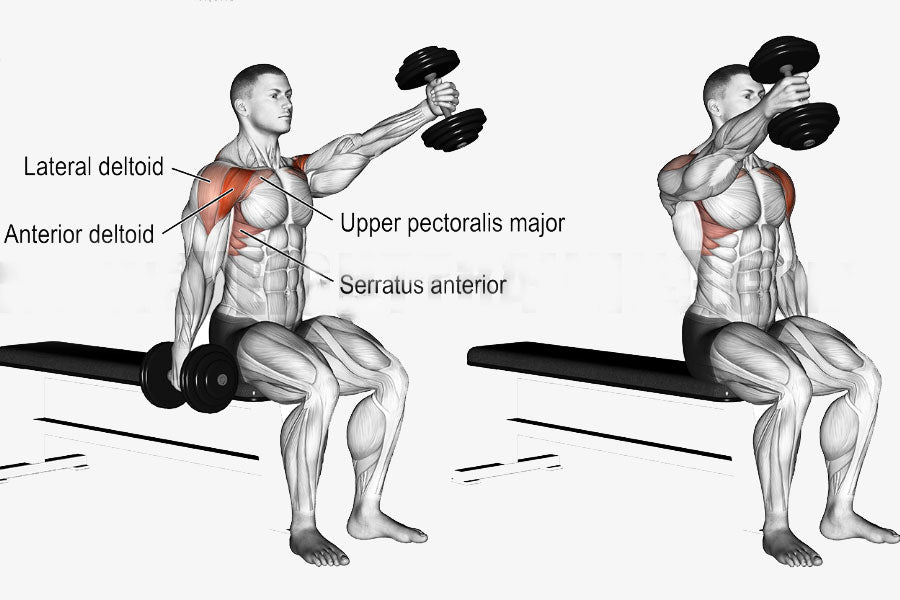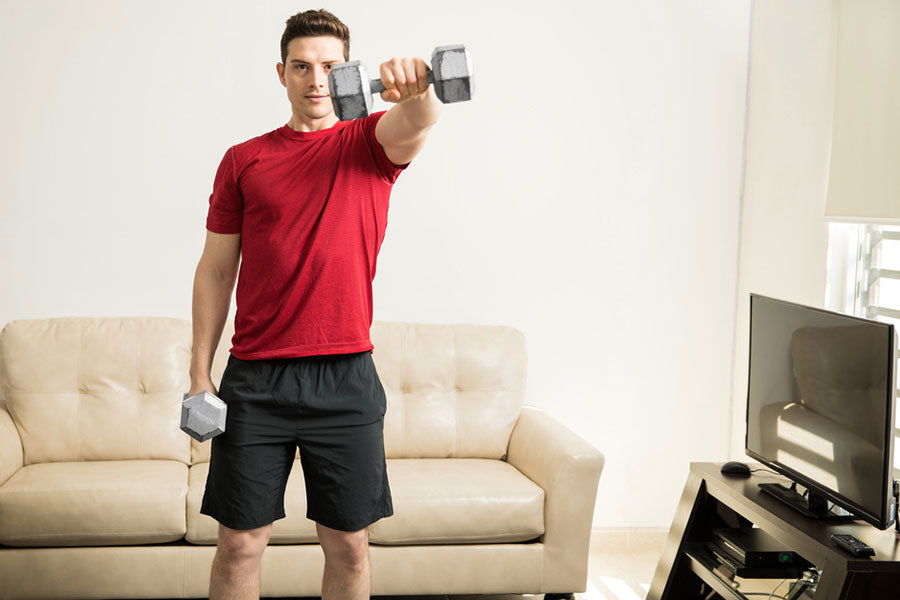There's nothing quite like the feeling of heavy dumbbells in your hands, and when it comes to working your shoulders, front raises are tough to beat. Front raises are a must-do exercise if you want to add some serious mass to your upper body.
Not only do front raises build big, strong shoulders, but they also help improve your posture and prevent injuries. When performed correctly, front raises place minimal stress on the joints and can be safely performed with heavy weights.
However, many people make the mistake of swinging the weights up and down, which puts unnecessary strain on the lower back and neck. In other words, many people perform this exercise incorrectly, leading to injuries.
The beauty of the dumbbell front raise is that it can be done almost anywhere with very little equipment. You only need a pair of dumbbells and a flat surface to rest them on. If you’re doing the exercise at home, you can use two water bottles or two cans of soup!
While sculpting your shoulders is an amazing exercise, performing it with the ideal form and technique is supremely important. This article will discuss this workout in detail to ensure you get the most out of it.
Related Article: Best Pull-Day Workout: Amazing Pull Exercises Explained By Trainers
How to Do a Dumbbell Front Raise

Let’s have a closer look at how to perform the dumbbell front raise perfectly:
- Start by standing with your feet shoulder-width apart and holding a dumbbell in each hand by your sides.
- Slowly raise one dumbbell up to shoulder height, keeping a slight bend to your elbow.
- Pause for a moment when you reach the top before lowering them back down to the starting position. That's one rep.
- Repeat for the desired number of reps.
While performing this exercise, there are certain things that you must keep in your mind. These tips will help you correct your form and prevent any injuries:
- Use a lightweight to start. You can increase the weight as you get comfortable.
- Keep your abdominal muscles pulled in, and avoid swinging the weights as you raise and lower them.
- Don't arch your back as you lift the weights. Instead, keep your spine in a neutral position.
- To make this exercise more challenging, try lifting one dumbbell at a time.
Benefits of the Dumbbell Front Raise
Dumbbell front raise is one of the most effective exercises to develop strong, sculpted shoulders. There are many benefits that this exercise serves your body. We have listed the most crucial ones below:
Tones Shoulder Muscles
The front raise is an essential exercise for anyone looking to tone their shoulders. By targeting the anterior deltoid muscles, the front raise helps enhance the size and definition of the shoulders. Plus, since the front raise is an isolation exercise, it's a great way to focus on specific muscle groups and ensure you get the most out of your workout.
Improves Range of Motion:
If you want to improve your shoulder flexion, then front raises are a great exercise to add to your routine. Front raises require your shoulder joint to go through a full range of motion, which can help increase your mobility. Additionally, front raises engage your shoulder flexor muscles, including the anterior deltoid and pectoralis major.
Targets Multiple Muscle Groups:
Front raises are a great way to target multiple muscle groups at once. In addition to the shoulder muscles, front raises activate the trapezius muscles in your upper back, the biceps and triceps muscles in your arms, the serratus anterior along your ribs, and the pectoral muscles in your chest - specifically the clavicular part of the pectoralis major.
Improves Posture:
The front raise is a great exercise for improving posture. Strengthening the muscles in the front of the body helps to pull the shoulders back and improve alignment. As a result, you will stand taller and feel more confident.
Muscles Worked in the Front Raise
We all know that strong, toned arms look great in sleeveless tops and dresses. But did you know that a dumbbell front raise is an excellent exercise for firming up your arms? This move targets the anterior deltoid muscles located at the front of the shoulders.
As we all know, strong shoulders are essential for good posture. The dumbbell front raise also helps strengthen the rotator cuff muscles, which are responsible for stabilizing the shoulder joint.
You can also add a bit of weight by holding the dumbbells in a neutral grip (palms facing each other) or using an angled grip (one dumbbell in each hand, palms facing down).
Related Article: Exhaustive Full Body Dumbbell Workout You Can Do At Home
Other Variations of Dumbbell Front Raise
If you wish to mix up things a bit and add a little zeal to your workout routine, here are some variations you can try.
Seated Dumbbell Raise

The Seated Dumbbell Front Raise is a great exercise for targeting the shoulder muscles. As the name suggests, you must be seated to perform this exercise properly.
Remember to breathe throughout the movement and to keep your core engaged. This exercise can be done with light weights for high reps or heavy weights for low reps. It's up to you! Ensure you are using good form and not sacrificing the range of motion for weight.
Dumbbell Front Raise With Hammer Grip

The dumbbell front raise with hammer grip is an excellent exercise for targeting the shoulder muscles. To perform the exercise, start by holding a dumbbell in each hand at shoulder level with your palms facing inwards towards your body.
From here, raise the dumbbells in a controlled manner until your arms are extended straight out in front of you. It works amazingly in preventing shoulder impingement. Keep your core engaged throughout the movement to avoid swinging the weights. Return to the starting position and repeat for desired reps.
Single Dumbbell Front Raise

Single dumbbell front raises are a great way to build strength in your shoulders. Unlike traditional front raises, which involve a dumbbell in each hand, this variation requires one dumbbell held by both hands.
This is beneficial because it creates efficiency and allows you to work both front delts at once. This can enhance strength gains and get the most out of your workout.
Barbell Front Raise

You can also perform this exercise with a barbell instead of a dumbbell. This can enhance the workout’s intensity and improve your muscles’ strength. It’s better to start with a lighter weight and then gradually increase as you get accustomed to it.
Related Article: 4-Day Barbell Workout Without a Rack for Complete Muscle Gain
Common Mistakes to Avoid
If you're new to working out, you might be eager to try every exercise you can think of. However, it's important to master the basics before moving on to more complex movements. The dumbbell front raise is a great exercise for targeting the shoulders, but it's also easy to get wrong. Here are some mistakes to avoid while performing this exercise:
Poor Form:
Remember to keep your back straight, and your core engaged throughout the movement. Otherwise, you risk injuring your lower back.
Momentum:
Once you start swinging the dumbbells up and down, it can be tempting to use momentum to help you lift the weight. However, this takes away from the effectiveness of the exercise and can also lead to injury.
Swaying:
Try to keep your body stationary throughout the movement. If you find yourself swaying from side to side, you're using too much weight.
Excessive Weight:
It's important to start light and gradually increase the weight as you get stronger. Using too much weight can lead to poor form and puts you at risk for injury.
Wrist Position:
Keep your wrists in a neutral position. They should not be bent up or down for effective results.
FAQs
1. Can I perform dumbbell lateral raises as a variation?
The dumbbell lateral raise is a great way to change your workout routine and target your shoulder muscles. This exercise is a great variation for those looking to add more diversity to their workouts.
The dumbbell lateral raise can be performed with either one or two dumbbells. If you use two dumbbells, simply hold them at your sides with your palms facing inward. If you use one dumbbell, hold an anchor to stabilize yourself.
2. Does a dumbbell front raise work the chest?
The dumbbell front raise is a move that targets the Anterior Deltoid, which is the muscle in the front of your shoulder. This muscle is responsible for horizontal abduction, which is the movement of your arm away from your body.
The front raise also works your Pectoralis Major to a minor degree. This is the muscle in your chest that helps you move your arm across your body. As a result, the dumbbell front raise is an effective move for working both your chest and shoulders.
3. Can you perform front raise with cables?
Cables are a great way to add resistance to your workouts, and they can be especially helpful when trying to target specific muscle groups. If you're looking to build strength in your shoulders, the front raise is a perfect exercise to add to your routine. And yes, you can absolutely perform this move with cables.
4. Is lateral or front raise better?
If you're targeting your medial delt muscles, then lateral raise is the way to go. But if you're interested in working your front delt, then front raise is the exercise for you. Of course, there are always exceptions to the rule.
For example, if you have an injury or condition that prevents you from performing a certain exercise, you'll need to find an alternative that works for you. But in general, lateral raise or front raise is the best way to target your shoulders, respectively.
The Bottom Line
To conclude, the dumbbell front raise is an essential exercise for any weightlifter looking to achieve greater gains in size and strength. While the exercise can be performed with strict form, many variations can be used to target different muscle groups.
The most important thing to remember when doing this exercise is to keep your core tight and avoid swinging the weights. You should also focus on using your shoulder muscles to do the work, not your arms. Using proper form and technique ensures that you are getting the most out of this exercise and achieving your fitness goals.
Reading List
Article Sources
- Botton, Cíntia E., et al. “Neuromuscular Adaptations to Unilateral vs. Bilateral Strength Training in Women.” Journal of Strength and Conditioning Research, vol. 30, no. 7, July 2016, pp. 1924–32. DOI.org (Crossref), https://doi.org/10.1519/JSC.0000000000001125.











